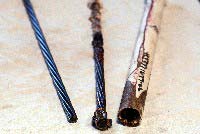U.S. oils can protect concrete bridge tendons during construction delays

An undamaged tendon (left) a tendon subjected to the salt solution test and the test tube. <br>Photo Credit: Greg Grieco, Penn State
A Penn State study has shown that there are U.S. oils that can match or exceed the characteristics of the European leader for temporary corrosion protection of concrete bridge tendons.
Dr. Andrea Schokker, the Henderson professor of civil engineering, who led the project, says, “The North American post-tensioning industry was considering importing the European product, possibly at higher cost than the oils available in the U.S. market. Our study established that there are adequate products available in North America to do the job.”
The study is detailed in the current issue of the Post-Tensioning Institute Journal in a paper, “Bond and Corrosion Studies of Emulsifiable Oils Used for Corrosion Protection in Post-Tensioned Tendons.” The authors are Edwin Salcedo-Rueda, a Penn State doctoral candidate in civil engineering; Schokker: Dr. John E. Breen, who holds the Nasser I. Al-Rashid chair in civil engineering at the University of Texas at Austin; and Dr. Michael E. Kreger, professor of civil engineering at Purdue University.
In post-tensioned construction, tendons made of seven twisted steel wires, are inserted into ducts that run the length of pre-cast concrete segments. The tendons are then stretched to put them under tension and anchored at the ends to hold the concrete segments in place. The ducts are eventually filled with portland cement grout which not only protects the steel tendons from corrosion but also distributes the bond with the tendon along its full length. When grouting delays occur, oil may be applied to the steel tendon to prevent corrosion during the unprotected period.
Schokker and her research team tested 19 anti-corrosion oils, 18 North American products and the European leader. The oils were subjected to three environmental tests and one mechanical test. The goal was to find oils that produce the least detrimental effects on the bond between the tendon and grout in addition to good corrosion inhibiting properties.
The environmental tests, which lasted six months, included exposing oil-coated tendons outdoors including an extreme Pennsylvania winter typical of the northern U.S.; laboratory exposure to 73 degrees F with 95 percent humidity comparable to some southern states and contact in sealed tubes with a diluted (five percent) salt solution, semi-controlled temperatures and variable relative humidity similar to saltwater coastal areas.
In the mechanical tests, the research group used a modified standard test to measure the force necessary to pull the tendon out of the grout.
The team found that six of the 18 domestic oils provided adequate corrosion protection in all three test environments. The top products from both the environment and mechanical tests were Citgo Cutting Oil NC 205, Shell/Texaco Dromus ABD and Shore Chemical Emul. Cutting Oil. These products have been recommended for Phase II testing at the University of Texas at Austin in large scale post-tensioned beams to examine bond and ultimate flexural capacity of structural members.
The study was supported by the Texas Department of Transportation and the Federal Highway Administration.
Media Contact
More Information:
http://www.psu.edu/All latest news from the category: Process Engineering
This special field revolves around processes for modifying material properties (milling, cooling), composition (filtration, distillation) and type (oxidation, hydration).
Valuable information is available on a broad range of technologies including material separation, laser processes, measuring techniques and robot engineering in addition to testing methods and coating and materials analysis processes.
Newest articles

Parallel Paths: Understanding Malaria Resistance in Chimpanzees and Humans
The closest relatives of humans adapt genetically to habitats and infections Survival of the Fittest: Genetic Adaptations Uncovered in Chimpanzees Görlitz, 10.01.2025. Chimpanzees have genetic adaptations that help them survive…

You are What You Eat—Stanford Study Links Fiber to Anti-Cancer Gene Modulation
The Fiber Gap: A Growing Concern in American Diets Fiber is well known to be an important part of a healthy diet, yet less than 10% of Americans eat the minimum recommended…

Trust Your Gut—RNA-Protein Discovery for Better Immunity
HIRI researchers uncover control mechanisms of polysaccharide utilization in Bacteroides thetaiotaomicron. Researchers at the Helmholtz Institute for RNA-based Infection Research (HIRI) and the Julius-Maximilians-Universität (JMU) in Würzburg have identified a…



